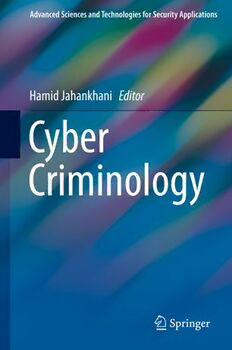
Cyber Criminology PDF
Preview Cyber Criminology
Advanced Sciences and Technologies for Security Applications Hamid Jahankhani Editor Cyber Criminology Advanced Sciences and Technologies for Security Applications Serieseditor AnthonyJ.Masys,AssociateProfessor,DirectorofGlobalDisasterManagement, HumanitarianAssistanceandHomelandSecurity,UniversityofSouthFlorida, Tampa,USA AdvisoryBoard GiselaBichler,CaliforniaStateUniversity,SanBernardino,CA,USA ThirimachosBourlai,WVU-StatlerCollegeofEngineeringandMineral Resources,Morgantown,WV,USA ChrisJohnson,UniversityofGlasgow,UK PanagiotisKarampelas,HellenicAirForceAcademy,Attica,Greece ChristianLeuprecht,RoyalMilitaryCollegeofCanada,Kingston,ON,Canada EdwardC.Morse,UniversityofCalifornia,Berkeley,CA,USA DavidSkillicorn,Queen’sUniversity,Kingston,ON,Canada YoshikiYamagata,NationalInstituteforEnvironmentalStudies,Tsukuba,Japan The series Advanced Sciences and Technologies for Security Applications comprises interdisciplinary research covering the theory, foundations and domain-specific topics pertaining to security. Publications within the series are peer-reviewedmonographsandeditedworksintheareasof: – biological and chemical threat recognition and detection (e.g., biosensors, aerosols,forensics) – crisisanddisastermanagement – terrorism – cyber security and secure information systems (e.g., encryption, optical and photonicsystems) – traditionalandnon-traditionalsecurity – energy,foodandresourcesecurity – economicsecurityandsecuritization(includingassociatedinfrastructures) – transnationalcrime – humansecurityandhealthsecurity – social,politicalandpsychologicalaspectsofsecurity – recognition and identification (e.g., optical imaging, biometrics, authentication andverification) – smartsurveillancesystems – applicationsoftheoreticalframeworksandmethodologies(e.g.,groundedtheory, complexity,networksciences,modellingandsimulation) Together, the high-quality contributions to this series provide a cross-disciplinary overviewofforefrontresearchendeavoursaimingtomaketheworldasaferplace. Moreinformationaboutthisseriesathttp://www.springer.com/series/5540 Hamid Jahankhani Editor Cyber Criminology 123 Editor HamidJahankhani QAHEandNorthumbriaUniversityLondon London,UK ISSN1613-5113 ISSN2363-9466 (electronic) AdvancedSciencesandTechnologiesforSecurityApplications ISBN978-3-319-97180-3 ISBN978-3-319-97181-0 (eBook) https://doi.org/10.1007/978-3-319-97181-0 LibraryofCongressControlNumber:2018960872 ©SpringerNatureSwitzerlandAG2018 Thisworkissubjecttocopyright.AllrightsarereservedbythePublisher,whetherthewholeorpartof thematerialisconcerned,specificallytherightsoftranslation,reprinting,reuseofillustrations,recitation, broadcasting,reproductiononmicrofilmsorinanyotherphysicalway,andtransmissionorinformation storageandretrieval,electronicadaptation,computersoftware,orbysimilarordissimilarmethodology nowknownorhereafterdeveloped. Theuseofgeneraldescriptivenames,registerednames,trademarks,servicemarks,etc.inthispublication doesnotimply,evenintheabsenceofaspecificstatement,thatsuchnamesareexemptfromtherelevant protectivelawsandregulationsandthereforefreeforgeneraluse. Thepublisher,theauthorsandtheeditorsaresafetoassumethattheadviceandinformationinthisbook arebelievedtobetrueandaccurateatthedateofpublication.Neitherthepublishernortheauthorsor theeditorsgiveawarranty,expressorimplied,withrespecttothematerialcontainedhereinorforany errorsoromissionsthatmayhavebeenmade.Thepublisherremainsneutralwithregardtojurisdictional claimsinpublishedmapsandinstitutionalaffiliations. ThisSpringerimprintispublishedbytheregisteredcompanySpringerNatureSwitzerlandAG Theregisteredcompanyaddressis:Gewerbestrasse11,6330Cham,Switzerland Foreword This book could not be more timely. Every day we learn of new developments in artificial intelligence. The Internet of Things (IoT) is becoming a kind of parallel universe. The skills of scientists and inventors have the capacity at their best to enhanceandevenextendlives,toprovidenewabilitiesforpeoplewithdisabilities, to make us all more inventive, to process in moments information that previously challengedthebestmathematicalandstatisticalskillsandtodevelopandsatiateour naturalcuriosity. At the same time, we know that the same skills in advanced sciences and technologies,ifmisused,willbetheinstrumentsofcrimeandevenoppression.Most users of the Internet experience weekly, if not daily, attacks on their privacy and financialintegrity,evenontheirveryidentity.Dataisminedandmisused.Sexually motivatedgrooming,bullying,victimisationandterroristradicalisationbecomeever more methodical and concealed. Like-minded criminals congregate on the Dark Web, using difficult to detect pseudonyms and acronyms, and often impenetrable security,toachievetheirpurposes. The benefits of artificial intelligence and the Internet of Things can be reaped beneficially only if sown securely; and the online world has not yet the power or creatormotivationtosecureitself. Nowhere have the challenges been demonstrated more clearly than in the efforts of the State to counter terrorism propagated on the Internet. Such has been the impact of radicalising websites, whether for violent Islamism or right-wing extremism, that the authorities are now removing tens of thousands of such sites everymonth.Althoughthatbattleisbeingwon,thisishappeningbyattrition,with thenetlossofsuchsitesoccurringataworryinglyslowpace. Cybercrimeishavinganevengreaterimpactthanterrorismonthegeneralpublic. Daily attacks are made on electricity and other energy suppliers, banks, law firms andaccountants,privatecompanies,medicalrecordsandothercaches ofevidence ofhumanactivity.Evenkeepingpacewiththeoperationalrangeofcybercrimeisa hugelyexpensiveendeavour. v vi Foreword This book provides instructive guidance for readers interested in tackling these huge,contemporaryproblems.Itexplainsthecriminologicalcontextofcybercrime. Itdemonstratesthementalandphysicalcomponentsthatarerequiredforreadersto understand cybercrime. It deals with the psychology of cyber criminals, analysing the motives which move them and the methodologies that they adopt. It sets out the intelligence networks that are used to bring together information about crime fallingintothisexponentiallygrowingcategory.ItexplainsthepoweroftheStateto interveneinprivatedataforthedetectionofcrimeandtheprotectionofthepublic. Also,itteachesreadersofthelegalprotectionsofconfidentiality,theextentofthose protectionsandtheextentandlimitsofdataprotectionlegislation. Thecategoriesofcrimedescribedinthebookareverywide.Theyareeverybit aspsychologicallycomplexasoffencesof,forexample,murderandmanslaughter. The extensive written or graphic evidential material comprising the actus reus of such crimes tells us much about the nature of the criminals who are undermining thebenefitsoftheelectronicworldbyabusingAIandIOT. Theavailableevidenceoftenisofakindanalogoustothatusedbypsychiatrists andpsychologistsinanalysingmentalhealth,motiveandlossofcontrolincrimes ofviolence.Thebookexplainshowsuchanalysiscanbeusedinunderstandingand therebydetectingtheperpetratorsofcrimesagainstconfidentialityandsafetyonthe Internet. The text will prove instructive to police and other regulatory authorities intheirpursuitofcybercrime.Itwillalsobeespeciallyvaluablefortheincreasing numberoforganisationswillingtotakeprivateprosecutionsagainstperpetrators,in cases in which the State does not act because of resource limitations. Deductive, psychologicallytrainedreasoningshouldenablethedetectionofmanycriminalsin thisrange. For AI and IoT to benefit society, it needs to be policed. That policing must be conducted in a strictly ethical context, proportionate and in the overall public interest. The ethical base must be founded on high-quality training, education and awarenessforallthosewhocarryoutthepolicing–justasethicalparametersshould besetoutduringeducationandtrainingforthosewhoarelearninghowtousethe advancedsciencesandtechnologiesunderdiscussion. Further,itisjustasimportantforsafetytobeawatchwordinthisvirtualworld asitisinthephysicalworld–aswhenweteachourchildrenacrosstheroadorto besafeintheirteenagelives. Thepotentialfortechnologytocauseorcontributetoseriousmentalillness,lack of confidence and economic failure cannot be exaggerated; just as its potential to create great happiness and economic and professional success knows almost no bounds. This book will provide professionals, teachers and students alike with an excellentreferenceguideforthemulti-facetedissueswhichwillcometheirwayin dealingwithadvancedtechnologiesintheyearstocome.Justastherearestandard worksoncriminallaw,familylawandthelawoftort,equallytherewillhavetobe standardreferencevolumesonlawfulandunlawfulactivitiesinthevirtualworld.I believethatthisvolumeisoneofthefirstofsuchworksandpromisesgreatbenefit. Foreword vii Inaddition,itprovidesanunderstandingofthepotentialofthecriminalandcivil jurisdiction in protecting the public from the kinds of crime under contemplation. There is bound to be an ever-increasing number of cases brought before courts, as dividing lines are set concerning the acceptability or otherwise of questioned behaviours. This is new territory for the judiciary too. Some judges are technically very proficient, whilst others less so. Non-specialist judges, including lay magistrates, will have to be able to deal with these issues. All would be well advised to read this important work. It will provide them with the full necessary background and answerstomanyofthespecificproblemsthattheywillencounter. In the years to come, we will be grateful for the impetus given in this area of thelawbyProf.Jahankhaniandhiscolleagueswhohavecontributedtothewidely rangingchaptersinthiswork. June2018 LordAlexCarlileofBerriewCBEQC Contents PartI CyberCriminologyandPsychology CrimeandSocialMedia:LegalResponses toOffensiveOnline CommunicationsandAbuse.................................................... 3 OriolaSallavaci Explaining Why Cybercrime Occurs: Criminological andPsychologicalTheories ..................................................... 25 LorettaJ.StalansandChristopherM.Donner CyberAggressionandCyberbullying:WideningtheNet ................... 47 JohnM.Hyland,PaulineK.Hyland,andLucieCorcoran PartII Cyber-ThreatLandscape Policies,InnovativeSelf-AdaptiveTechniquesandUnderstanding PsychologyofCybersecuritytoCounterAdversarialAttacksin NetworkandCyberEnvironments............................................. 71 RezaMontasari,AminHosseinian-Far,andRichardHill TheDarkWeb.................................................................... 95 PeterLarsDordal TorBlackMarkets:Economics,CharacterizationandInvestigation Technique ......................................................................... 119 GianluigiMeandLiberatoPesticcio ANewScalableBotnetDetectionMethodintheFrequencyDomain...... 141 GiovanniBottazzi,GiuseppeF.Italiano,andGiuseppeG.Rutigliano PartIII CybercrimeDetection Predicting the Cyber Attackers; A Comparison of Different ClassificationTechniques........................................................ 169 SinaPournouri,ShahrzadZargari,andBabakAkhgar ix x Contents CrimeDataMining,ThreatAnalysisandPrediction........................ 183 Maryam Farsi, Alireza Daneshkhah, Amin Hosseinian-Far, OmidChatrabgoun,andRezaMontasari SMERF:SocialMedia,EthicsandRiskFramework ........................ 203 IanMitchell,TraceyCockerton,SukhvinderHara,andCarlEvans UnderstandingtheCyber-VictimisationofPeoplewithLongTerm Conditions and the Need for Collaborative Forensics-Enabled DiseaseManagementProgrammes............................................. 227 Zhraa A. Alhaboby, Doaa Alhaboby, Haider M. Al-Khateeb, GregoryEpiphaniou,DhouhaKbaier BenIsmail,HamidJahankhani, andPrashantPillai AnInvestigator’sChristmasCarol:Past,Present,andFutureLaw EnforcementAgencyDataMiningPractices.................................. 251 JamesA.Sherer,NicholeL.Sterling,LaszloBurger,MeribethBanaschik, andAmieTaal DaP∀: Deconstruct and Preserve for All: A Procedure for the Preservation of Digital Evidence on Solid State Drives and TraditionalStorageMedia...................................................... 275 IanMitchell,JosuéFerriera,TharmilaAnandaraja,andSukhvinderHara PartIV Education, Training and Awareness in Cybercrime Prevention An Examination into the Effect of Early Education on Cyber SecurityAwarenessWithintheU.K............................................ 291 TimothyBrittan,HamidJahankhani,andJohnMcCarthy An Examination into the Level of Training, Education and Awareness Among Frontline Police Officers in Tackling CybercrimeWithintheMetropolitanPoliceService......................... 307 HomanForouzan,HamidJahankhani,andJohnMcCarthy CombatingCyberVictimisation:CybercrimePrevention................... 325 AbdelrahmanAbdallaAl-Ali,AmerNimrat,andChafikaBenzaid InformationSecurityLandscapeinVietnam:InsightsfromTwo ResearchSurveys................................................................. 341 Mathews Nkhoma, Duy Dang Pham Thien, Tram Le Hoai, andClaraNkhoma
